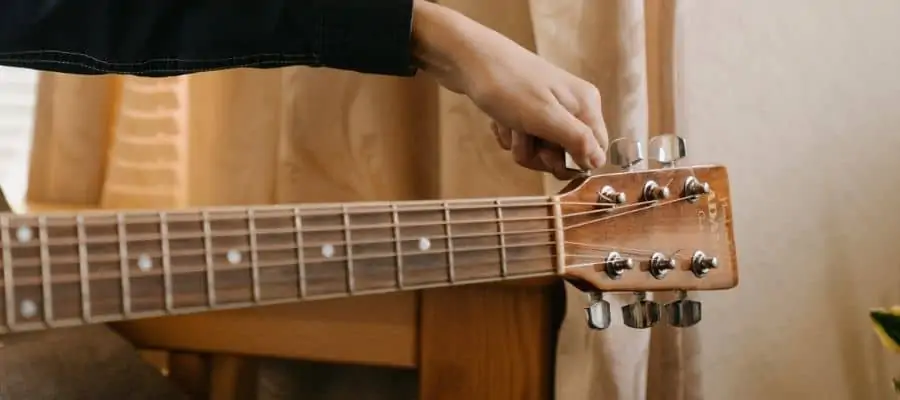Drop C tuning is often associated with heavier music genres requiring a deeper, resonant guitar sound. It involves lowering the pitch of each string, with the sixth string going down two whole steps to C and the others typically down one whole step. This creates a thicker tone suitable for certain styles of music. One common concern is whether this tuning method harms the guitar or not.
While radical detuning can require adjustments to maintain optimal playability, drop C tuning is not inherently harmful to your instrument. However, it’s crucial to understand that proper setup and attention to string tension are key to preventing issues.
The main considerations for those who frequently switch tunings, particularly to drop C, include ensuring string gauge compatibility and adjusting the guitar’s truss rod if necessary. It is recommended to use heavier gauge strings. Therefore, you have to adjust your guitar action according to that. A proper setup ensures that the neck tension accommodates the new string tension without causing damage. Using heavier gauge strings can also offset the reduced tension when tuning down.
Concerns about drop C tuning damaging the guitar are largely unfounded as long as you take care of these aspects. Moreover, the belief that it’s bad for the intonation is exaggerated; while intonation adjustments might be needed, it does not mean your guitar will suffer. It’s all about keeping your instrument calibrated for the tuning you choose.
Understanding Drop C Tuning

Drop C tuning is often misunderstood as something that could harm your guitar. In reality, it’s simply a variation of the standard tuning, adjusted to accommodate heavier music genres or vocal ranges. Separating the myths from the facts is crucial to ensure you’re both informed and comfortable with this tuning method.
Definition and History
Drop C tuning modifies your guitar’s string pitches to C-G-C-F-A-D. It’s characterized by a low and heavy sound that’s particularly favored in metal and rock music. This tuning can be traced back to the early days of these genres, where heavier, darker sounds were sought to match the intensity of the music.
To tune your guitar to Drop C:
- Lower the 1st string a whole step to D.
- Proceed to drop each remaining string down a whole step.
- Adjust the pitch of the 6th string again, dropping it to C.
Comparing Drop C to Standard Tuning
Drop C tuning is notably different from the standard E-A-D-G-B-E tuning. The pitch of each string in Drop C is lowered, with the sixth string dropping by two whole steps compared to standard tuning.
Key differences:
- Pitch: In standard tuning, strings are higher in pitch, which gives a brighter tone.
- String Tension: Drop C tuning results in looser strings, affecting playability, and heavier gauge strings to maintain tension would be recommended in his case.
- Vibration Space: Lower tunings need more room for string vibration, implying that setup adjustments, like action height, might be required.
By understanding Drop C tuning, you can explore its creative possibilities without fearing damaging your instrument.
Effects of Drop C on Guitars

When you switch to Drop C tuning, where the strings are tuned to CGCFAD, it’s not inherently harmful to your guitar, but it does necessitate some specific adjustments and awareness of potential issues. The shift in tension, pitch, and string thickness requires attention to your instrument’s setup to maintain its playability and longevity.
String Tension and Neck Stress
String Tension: In Drop C, your guitar’s strings will have lower tension than standard tuning. This can lead to less stress on the neck.
- Neck Stress: Your guitar’s neck could bow slightly due to decreased tension. It may be necessary to adjust the truss rod to maintain proper neck alignment to balance it.
Saddle Adjustments
Intonation adjustments at the saddle are essential to ensure accurate pitch across the fretboard, compensating for the altered string tension.
Long-Term Instrument Health
Regular checks and potential adjustments to the truss rod, nut, and saddle are crucial for the health of your guitar. Maintaining these components lets your guitar handle Drop C tuning without adverse long-term effects. Remember, correct setup is key to preserving your instrument’s integrity while enjoying the deeper, heavier sound that Drop C tuning offers.
Frequently Asked Questions

Drop C tuning can be an intriguing variation for guitarists to explore, offering a distinctive tone and feel. However, it can provoke questions regarding the instrument’s health and playability, particularly among players new to alternate tunings.
Can using Drop C tuning warp my guitar neck over time?
Your guitar’s neck is built to withstand tension variations, so Drop C tuning shouldn’t warp the neck over time. Nevertheless, a proper setup by a professional can ensure that any changes in tension do not affect the neck’s stability.
What are the pros and cons of playing in Drop C as a beginner?
Pros: Drop C tuning can make it easier to play power chords, inspire creativity, and help you achieve a heavier sound, which is excellent for specific genres.
Cons: It may require learning new chord shapes and heavier gauge strings to maintain tension.
How do chords change when you switch to Drop C tuning?
When you switch to Drop C, chord shapes will change. Standard chords will sound different; you’ll need to adapt or learn new appropriate shapes for this tuning to play chords correctly.
Is there a difference in sound quality when playing Drop C on an acoustic vs electric guitar?
Drop C will generally give you a darker, more resonant tone on an acoustic guitar, while on electric, it can amplify the low-end growl and provide a heavier sound, especially suited for genres like metal and hard rock.
What are some of the main reasons musicians use Drop C tuning?
Musicians often use Drop C tuning to achieve a lower, heavier sound that resembles aggressive music styles, like metal. It also allows for easier formation of barre chords and can add a fresh creative angle to songwriting.
Are there any risks to the guitar if I frequently switch between standard and Drop C tunings?
Regularly changing between standard and Drop C tunings can cause additional wear on your guitar’s hardware, especially the tuning pegs. It’s advisable to make changes gradually and ensure your guitar is correctly set up for the changes in tension.
Conclusion
In addressing concerns about whether Drop C tuning harms your guitar, it’s evident that your instrument can handle this alternate tuning without adverse effects with proper adjustments. Selecting the heavier string gauge and modifying your guitar setup, including the truss rod and intonation, is key to accommodating the lower tension.
Remember, routinely checking the neck for bowing and ensuring the guitar’s intonation is calibrated are good practices regardless of tuning.
If you enjoy the rich, deep sound that Drop C tuning offers, there’s no need to shy away from it. With attention to detail and care for your instrument, you can relish the creative possibilities Drop C tuning brings to your playing experience.
If you found this article useful, you may want to save this pin below to your Guitar board.

Recent Posts
Some guitarists insist on buying an expensive amplifier with their electric guitar. They assume that this is a must for every type of guitarist out there. However, in some situations, this isn’t...
Top 50 Free Realistic Guitar VST Plugins With Sound Examples
As technology has rapidly advanced in the recent decade, computers are stealing more and more roles from physical musical instruments and accessories. Nowadays, you do not need expensive amps,...

